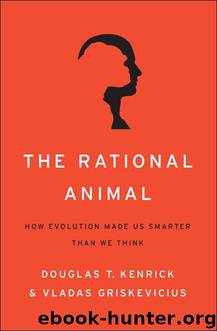The Rational Animal: How Evolution Made Us Smarter Than We Think by Kenrick Douglas T. & Griskevicius Vladas

Author:Kenrick, Douglas T. & Griskevicius, Vladas [Kenrick, Douglas T.]
Language: eng
Format: epub
ISBN: 9780465040971
Publisher: Basic Books
Published: 2013-09-10T00:00:00+00:00
FAST AND SLOW PEOPLE
Recall that some animals, like tenrecs, follow a fast life history strategy (investing very little in somatic effort and instead focusing on mating), while other animals, like elephants, follow a slow strategy (investing heavily in somatic effort and delaying reproduction). Life history theory emphasizes that neither strategy is inherently better. Instead, each is evolutionarily suited to different environments.
Fast strategies are adaptive in environments that are dangerous and unpredictable, like that of tenrecs, whose life is treacherous and uncertain. Not only must tenrecs endlessly scour for dinner in a desiccated Madagascar desert, but predators lurk behind every bush, on the lookout for a delicious tenrec dinner themselves. For critters living in a dangerous and unpredictable world, following a fast strategy is a necessity. If they delay investing in reproductive effort, they risk not reproducing at all. Tenrecs simply can’t afford to build a larger bank account, because they might not be around later to spend their savings.
Slow strategies, on the other hand, are adaptive in safer and more predictable environments. Unlike tenrecs, elephants feed on a predictable diet of regional vegetation, and their massive size and power protects them from most predators. The adaptive strategy for elephants is to take their time, grow, and learn more about their world. With the luxury of being able to pad their somatic bank account, elephants invest more in somatic effort, thereby making themselves more competitive as mates in the future and, ultimately, better parents.
But here is where things get even more interesting. Differences in life history strategies don’t just apply across different species. Individual animals within a given species also differ in their life history strategies. Some elephants and tenrecs reproduce earlier, while other elephants and tenrecs reproduce later. The same is true for humans. Although humans are relatively slow compared to other species, some people start families earlier, and others start them later. In the United States, for example, although the average age of first-time mothers is twenty-five, more than one in five first births occur to women under age twenty, while one in ten occur to women over the age of thirty-five. Some people are faster than average; others are slower. And on closer examination, these differences are not just random variations in whether or not a woman happens to become pregnant. Instead, fast and slow strategies are associated with vastly different psychologies and vastly different orientations toward everything from family to sex to money.
Slow strategists tend to be late bloomers. They actually grow up less rapidly, start puberty at later ages, and age biologically at a slower rate. They start having sex later in life and have fewer sexual partners, preferring monogamous relationships. People on the slow path also tend to have fewer children, to have them later in life, and to be married when they do so.
In sharp contrast, people on the fast track grow up more rapidly, start puberty at earlier ages, and age biologically at a faster rate (if you’ve ever been to a high
Download
This site does not store any files on its server. We only index and link to content provided by other sites. Please contact the content providers to delete copyright contents if any and email us, we'll remove relevant links or contents immediately.
International Integration of the Brazilian Economy by Elias C. Grivoyannis(98862)
The Radium Girls by Kate Moore(11970)
Turbulence by E. J. Noyes(7977)
Nudge - Improving Decisions about Health, Wealth, and Happiness by Thaler Sunstein(7656)
The Black Swan by Nassim Nicholas Taleb(7055)
Rich Dad Poor Dad by Robert T. Kiyosaki(6513)
Pioneering Portfolio Management by David F. Swensen(6253)
Man-made Catastrophes and Risk Information Concealment by Dmitry Chernov & Didier Sornette(5956)
Zero to One by Peter Thiel(5731)
Secrecy World by Jake Bernstein(4698)
Millionaire: The Philanderer, Gambler, and Duelist Who Invented Modern Finance by Janet Gleeson(4421)
The Age of Surveillance Capitalism by Shoshana Zuboff(4243)
Skin in the Game by Nassim Nicholas Taleb(4201)
Bullshit Jobs by David Graeber(4138)
The Money Culture by Michael Lewis(4132)
Skin in the Game: Hidden Asymmetries in Daily Life by Nassim Nicholas Taleb(3960)
The Dhandho Investor by Mohnish Pabrai(3722)
The Wisdom of Finance by Mihir Desai(3693)
Blockchain Basics by Daniel Drescher(3540)
